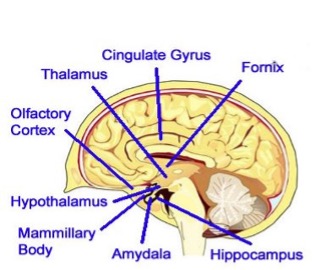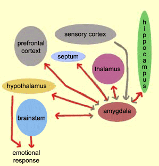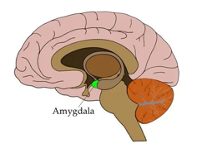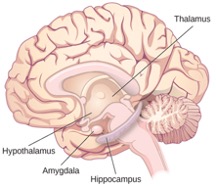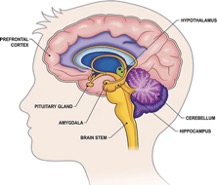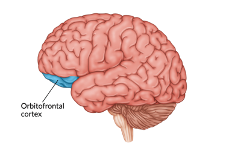The modern understanding of emotion creation, processing and transmitting is usually connected with James Papez’ studies and findings. According to Anita Deak: “Papez (1937) has described not one single center for emotions (such as the thalamus or the hypothalamus) but a neural circuit within several brain structures. The Papez circuit consists of the thalamus, the hypothalamus, the mamillary bodies, the cingular gyrus, and the hippocampus (Dalgleish, 2004). He has also suggested pathways among these structures where information is transmitted during an emotional state. (…)
Where do emotions come from? The emotional brain
3 Topics | 2 Quizzes
Classification of emotions
3 Topics | 1 Quiz
Emotions and the social brain
2 Topics | 1 Quiz
Learning and emotions
4 Topics
The emotional brain – emotion creation, processing and transmitting
The limbic system has often been mentioned as the central region for emotions. (…) The limbic system consists of the Papez circuit extended with the septal areas, the nucleus accumbens, the amygdala and the orbitofrontal cortex” (Deak, 2011: 72).
If you want to read more about the emotional brain:
- Dalgleish, T. The emotional brain. Nature Reviews Neuroscience, vol. 5, no. 7, pp. 582–589, 2004. https://stanford.edu/~knutson/ans/dalgleish04.pdf
- Deak, A. Brain and emotion: Cognitive neuroscience of emotions. Review of Psychology, 2011, Vol. 18, No. 2, 71-80. http://mjesec.ffzg.hr/revija.psi/vol%2018%20no%202%202011/Deak%203.pdf
The parts of the limbic system function in an integrated way and are mutually dependent in the process of creating and transmitting emotions. Kathryn Elizabeth Patten notes about the complexity of these relations:
“Neuroscientists have rejected the idea that specific parts of the brain perform designated singular tasks and assert that brain parts are highly integrated (Murphy, Nimmo-Smith, & Laurence: 2003), and while specific parts such as the amygdalae function as the hub for certain tasks, they do not perform these tasks alone, but serve to orchestrate and coordinate neuronal activity. Damasio, Ledoux, and Goleman focus on the neural and physiological substrates of emotion as a basis for their theories and hypotheses about the role of emotion (Patten: 2008).”
The emotional brain - the amydala
What does the amygdala represent and where is it located?
The amygdala is a collection of nuclei found deep within the temporal lobe. The term “amygdala” comes from Greek and means “almond“, because one of the most prominent nuclei of the amygdala has an almond-like shape. Although we often refer to it in the singular, there are two amygdalae—one in each cerebral hemisphere.
What are the functions of amygdala?
Sometimes it is called “the aggression centre”. The amygdala is related to emotion, particularly in processing of aversive information (LeDoux: 1996).
It is best known for its role in the processing of fear (and also anger and anxiety), but this is an oversimplified perspective on amygdala function.
There is evidence that amygdala is also involved in processing pleasant information, such as:
- related to reward-learning (Adolphs: 2010; Janak and Tye: 2015),
- episodic memory encoding (Hamann et al.: 1999; Dolcos et al.: 2004),
- pleasant scene or face perception (Sabatinelli et al.: 2011),
- mental imagery of pleasant experiences (Costa et al.: 2010).
In a broader sense, the amygdala is a key structure triggering the organisms’ survival circuit (fight or flight reactions) that is organized into distinct motivational systems, the appetitive and defensive motivation system (Lang, Bradley: 2010).
Other brain structures responsible for the formation and processing of emotions
THALAMUS – a sensory relay center (collects sensory inputs: visual, auditory and somatosensory), its neurons project signals to both the amygdala and the higher cortical regions for further processing.
HYPOTHALAMUS – is involved in emotion expression, rather than their generation. Its role extends over many levels, regulating motor skills, emotional responses, blood pressure, etc.HIPPOCAMPUS – associated with learning and emotions. It is a key part in the emotional brain network and is responsible for social cognition and emotion processing. It is also important in spatial memory, navigation, and helps turn short-term memory into long-term memory.
Orbitofrontal cortex
One of the major theories of emotion is that emotions are states elicited by rewards and punishers, which are instrumental reinforcers (Rolls, 2000, 2013b, 2014, 2018a) (Fig. 6). According to this theory the role of the OFC in emotion is to decode the reward/punishment goals for action, by representing reward value, and by learning about stimuli with reward versus non-reward contingencies, and then to transmit the resulting representations to further brain regions (such as the cingulate cortex) which implement the learning of actions to obtain the reward outcomes, signalled by the OFC (Rolls, 2019a,b; Rolls, 2021a).
Although the amygdala has many of the same connections as the OFC, it is an evolutionarily old brain region, and appears to be overshadowed by the OFC in humans, in that the effects of damage to the human amygdala on emotion and emotional experience are much more subtle. LeDoux and colleagues have emphasized the evidence that the human amygdala is rather little involved in subjective emotional experience (LeDoux, Pine, 2016; LeDoux, Brown, 2017; LeDoux et al, 2018). That is in strong contrast to the OFC, which is involved in subjective emotional experience.
These processes—assessing the social rank of individuals, learning from social partners, anticipating their behaviour—are critical for social life. However, the balance (of functions of amygdala and OFC) may shift towards the OFC in humans, in that it is OFC damage in humans that produces profound changes in social and emotional behavior, and subjective emotional experience, as well as in reward reversal learning (Rolls et al., 1994; Hornak et al., 1996; 2003; Berlin et al., 2004, 2005; Hornak et al., 2004; Rolls, 2019c).
Quizzes
